Don’t miss growing your skills…

The tool cupboard build is now filmed and going to every country around the world. It’s one of those bigger series we do now and again. This project covers many key aspects used throughout furniture making mostly because I wanted to impart the development to include many elements of cabinet making by hand.
Creative development always demands skill, flair and a willingness to develop growth in a variety of techniques. Every crafting artisan I ever met sees something hard to do and rises to the challenge by asking how it’s done. Self-demand is what makes the difference to developing artisans and no artisan ever deprives her or himself of bettering their work, increasing their knowledge and maximising their skill levels. They know they don’t arrive there without acknowledging that new things are stepping stones to betterment and as such are always somewhere in the background waiting to be revealed.
Here is the list of what’s being taught in this extensive series:
Large scale dovetailing in hardwood.
Making a dovetail duplicator for hand tools (Guaranteed replication for 10 or a hundred dovetails). A Paul Sellers’ dovetailing system.
Cabinet construction (Tricks for gluing up large dovetails to avoid joint freeze).
Framed panel construction.
Ploughing grooves by hand methods.
Perfecting mortise and tenons using the Paul Sellers system.
How to make a door of any size and style.
How to fit a door of any size.
How to hang a door of any size.
Recessed door alignement.
Final fitting a recessed door.
How to size a recessed drawer for a dead fit.
How to make half lap (half blind USA) dovetails using two methods.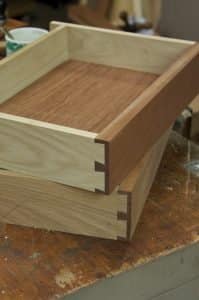
How to develop perfect dovetails using the Paul Sellers’ system
How to make housing dadoes with through tenons.
How to make cockbeading by hand.
How to apply bead to a panelled door.
How to make a poor man’s mitre box.
How to make moulded stock by hand.
How to develop and make hand made coved cornice.
How to fit handmade coved cornice.
How to make saw tooth adjustable shelf bracket.
How to fit adjustable shelving to saw tooth bracketing.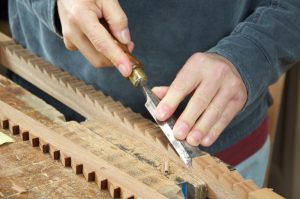
How to hang a tool cabinet.
There is as always much more to this than listed but it does show how expansive our work is these days. The methods we teach and train woodworkers to do are not just how to cut and form this or that but to consider the serious elements that guarantee no twisted drawers and doors, things like that that are critical to the final performance of the piece. Feedback from thousands of people following us through the years is proving ever more that what we are doing is constantly changing the face of woodworking for the better. We are proving that real woodworking and the Real Woodworking Campaign we started years ago has got guts, real value and the power to change people’s perspectives.
Though this is a tool cupboard to date, the build gives instruction for building the upper cabinets for kitchens and other household or office cupboards and cabinets too. We don’t turn on any machines and though some find it hard to believe this cabinet is about two weeks worth of very detailed hand work for me. That’s about 100 hours. I would sell a small cabinet like this for around £3,000, but only if I liked the buyer. So when someone says to me that you can’t make your living from woodworking by hand I just suggest to them to get a life and lower their living standards. Anyone that can’t live on £40,000 a year without commuter expenses and little overhead beyond a garage sized workshop should consider lowering aspirational levels and embrace the benefits beyond the dollar. For me that was a major decision that led to sanity.
Oh, remember too. None of this came from anything but hand tools!


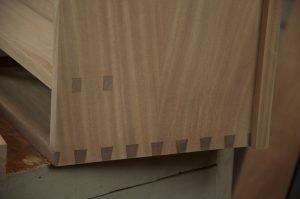
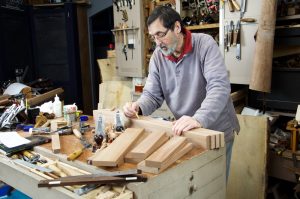
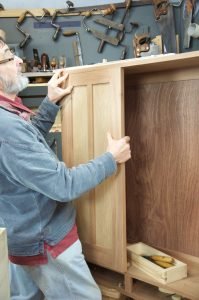



Mr. Sellers;
Absolutely outstanding work that cupboard. That list of skills is daunting.
A year ago I sold all my power tools (wasn’t having much luck with them anyway) and bought a couple of hand planes. Then after sharpening and tuning them up, I planed and planed and then I planed some more, making little boards out of big ones. To test my skill at flattening and squaring stop. When I think I’m there I take a knife line around the board with my square to see if I could come back to where I started. A few months ago I worked some rough lumber, flat and square and my lines met (I save the board). Since then they meet more often than not. If they don’t, I’m off by only a fraction. A beginner skill developing to be sure, but I had to start somewhere. Now I focused on sawing skills.
Please keep up the good work and encouragement.
Happy Holidays
Tom
dear tom–
Amen brother. I can’t count the number of times I had to futz with things because I didn’t get the basics down. Finally figured it out, and since then no more bizarre dovetails or squished boxes. A merry christmas to you too.
Absolutely beautiful. Thank you for all you are teaching us. Merry Christmas to you and your family and staff.
This article gives me two thoughts:
1. OK, you’ve convinced me that I should upgrade to the paid membership of the Masterclasses, as I’d love to learn the techniques listed above.
2. In an earlier blog Paul alluded to the “death of quality and craftsmanship” and “the deplorable 32mm European hinge system”. Clearly this cabinet is a work of art, but at £3000 it’s obviously way out of reach for all but the financially privileged. IKEA may be an anathema to the craftsman, but the reality is that the average consumer simply couldn’t afford the work of that craftsman. I’m not making a negative point about craft, just that cost effective mass produced designs fill a need, and, whilst inferior, a mediocre cabinet is more useful than no cabinet.
When I first got into this business of furniture building one of my very first questions ,who was I going to build for. Which type of customer do I want to target.
Basically ,I had two choices. The middle class or the rich.
I have to say ,that was one of the easiest decisions I’ve ever made.
Don’t get me wrong I still will make a piece for any customer. I’m not that mad at money. Not yet anyway. Lol
It’s amazing how many well off people there are out there and what’s even more facinating is the more a piece cost the better quality customer it attracts .I think it’s mainly because , by nature people are curious and for the wealthy they like to show off with their expensive everything.
It’s the pieces that you make the least on that seem th cause the most strife. Go Figure uh?
That’s just the facts. And that doesn’t just pertain to Cabinet Maker’s or for Joiner’s but in all sales, house’s , Cars, Musical instruments , ect.ect.
And this is when I was using mainly machines to build with.
For one second , just forget about money,
More important than all of this Is the fact that I will I never have to work another day for the rest of my life.
It’s only work when your not 100% happy with what your doing, and believe me you will know when it happens. . That’s the beauty of it all.
Have a Merry Christmas to you all. .
Christopher – I agree.completely, and if I had the talent to produce work of a good enough standard I’d target the high end too (fewer, more discerning, customers, vs trying to please the masses). It’s just that there is a place for the mass manufactured designs.
I have signed up for the full membership now though, and I’m definitely enjoying this series (albeit I’m only one and a half episodes in).
I found your website and youtube channel earlier this year, and I’m happy to say that you inspired me to become a craftsman. Next year I turn 20 and begin my first job as a furniture maker’s apprentice, and I’ve never been happier. Thank you very much Mr. Sellers, merry Christmas!
Where can this series be purchased?
It is a membership to woodworkingmasterclasses.com, Bill.
Thanks, Paul.
This could well tip me into paid subs too, Paul. A great list of skills, most of which I still need to acquire. I think my Christmas present to myself will be to join the Masterclass. Really pleased you decided to do this one, you can only learn so much from Hayward books and the like, so much more useful to see things ‘in motion’ and especially to learn what can go wrong and how to ensure it doesn’t. Have a lovely Christmas.
To have the ability to make a cupboard of that quality in 100 intensive hours is a rare quality. Even rarer is the ability to discerningly sell it to ‘someone you like’ for £3,000. To make a living by selling the equivalent of 14 of those to make £40,000 a year would require an additional rare marketing talent. The market for such quality must be there, but how on earth does one tap into that while dedicating oneself to the production of such quality items? For myself, I have had one visitor to my house say ‘name your price’ for a table I have made myself but I could never see myself making such items commercially because of the months each one takes. For me it will remain a hobby to be able to produce for myself and for others as presents, items of real quality. So thanks Paul for the direction and inspiration to be able to produce such stuff.
I don’t have the skill to make a living building furniture, but I know it is possible. I had a Uncle who did very well doing that for many years. I think the secret is to do quality work and just begin. My Uncle started by building kitchen cabinets in the days before the big box stores took over that business. As that business began to fade away he shifted to building quality furniture to order. Most of what he built were colonial reproductions, because that is where the market seemed to be. For many years he never lacked for customers.
My wife cannot understand how I can sit mesmerized watching the master at work. I have made a few of Paul’s projects and have ‘Stored’ the others for future builds, although from each I take away so much knowledge and understanding. Even if I am not building Paul’s project I still call upon his techniques.
Paul.. 100 hours??? is that for one cabinet or the couple you make as the teaching aids / examples and the time spent talking / teaching us disciples?
Thank you from your many followers 🙂
I just turned eighteen, and for just over a year now I have been working on woodworking with mostly, if not only hand tools after discovering Paul when trying to figure out how to make mortises without a $500 mortising machine. As Paul has described before, I loved working with wood in shop class but something was missing. I hated fighting with the machines just to feed it the wood and not actually work it myself. there was just something missing, and thanks to Paul I have discovered real woodworking and am trying to get my income from woodworking, alongside growing a large garden to sell produce at the farmers market ( summer 2015 was my first farmers market experience), and expanding my chicken egg business that I began at 13 or so. I also work on the farm with my dad, which I do love farming too but having my own farm to manage seems to be pushed out of the picture.
My dream, that has really turned into a passion, is to not work for and depend on someone for my income and follow the conveyor belt that my peers have been trained to stay on. I want to be able to make and create with my own hands and do the things that I love for a living, even though everyone says that it isn’t possible. My family implies that the things I am trying to do for income will just turn into a hobby and that it’s not possible to live that way.
I had a few questions for Mr. Sellers and anyone else who would like to pitch in.
It takes me about ten and a half hours to make the clock from Paul’s masterclasses, does this seem like a lot?
the first four clocks I sold through my mom at her work, three of them stained, at a low price of $65 (at that time I had no idea how much time it took me) of course I found out that it was not economical for me to sell them that low. And please do not get the impression that I am in this for “the money”, Considering how much I sell something for is just something that has to happen in order for this to be more than a hobby.
So, I reconsidered my expenses and factored in how long it takes, and if I sell a hardwood clock (oak, mahogany) for $120 than that leaves me about $90-$100 profit. that’s a little less than ten dollars an hour, and for now I am perfectly happy with that. The only problem is I can’t find a buyer. I will say that I only tried to sell an oak clock at the farmers market, so that could be why it did not sell.
I also have made some of the carrying totes in woodworking masterclasses, I have sold one of those for $35 to a teacher, and advertised one at the farmers market the whole season, Is this to much or too little?
Also, I have made wooden spatulas of my own design. They look somewhat like those “rubber scrapers” that pretty much every kitchen has. I sell these for $15 in walnut or hard maple is what I have done so far. I have sold one of those at the farmers market in walnut and a set of four different sized ones to a friends friend, but he would only by them for $12.50 a piece. the spatulas take me about one and a half hours not including putting the mineral oil on.
I really love all the things I said I do here, and wood working has really developed into so much more than just woodworking to me. If I could just getting the selling and pricing problems out of the way, I couldn’t imagine doing anything else for a living. That’s including growing things and having chickens of course.
Sorry for such a long comment. Thank you so much Paul and team for all that you have done. You really have taught me so much more than just wood working, and to me that means a lot. thank you.
I would accept that it is possible to make a living from making furniture, but I would love to know if anyone has done it to the extent of using hand tools that Paul espouses eg ripping boards with a hand saw rather than a circular saw or band saw. My own brother-in-law made a modest living as a miniature ship wright, selling models at up to £10,000, but he took a very pragmatic approach to machines, using them whenever it was easier. Even Paul starts from machined boards – he just never shows us that part of the process!
David, You must understand that my ambition is to offer additional dimension to a new and modern world. 99% of people reading and watching have not intention of changing their current jobs because the current world is cheapened when it comes to wooden things. I want people to be able to make beautiful things using skilled work. This then works for the 99%. I want people to use machines if they want to, but I do not want people to feel they can’t if they don’t want to. I have said this before, children are isolated from the worksop that’s dedicated to machine only methods. Half the woodworking population is also isolated from it if they were to have to use machines because they rightly see machine woodworking as exceptionally dangerous. So this is a winner for the majority of my audience. Those who want to make their living from their hands will most likely need to work with some power equipment. What’s wrong with that? Well for the majority, nothing, but for those who feel intimidated they must find strategies that work. It can indeed be done say if you pick the projects you make that are well suited to hand work only. For instance a violinmaker needs no machines to ever make a violin and guitars too come from hand tools no problems. Sam just made a wide range of pieces over the past 9 months or so including a commission for two coffee tables and in January he will be making a dining table commission. With the portfolio he has been building and the work he has made this years he would have made his first £10,000 which when you consider the amount of none paying work he has had to do to become proficient is quite remarkable. I think that he is capable of making and selling £600 of work in a six day week which is a standard week for a self employed craftsman. he will get better and more efficient as his skills and decision making gets better. I think the way I best described it in past blogs is that machines work great for donkey work and that includes the dimensioning of wood. I assume from what most people tell me that most people have access to dimensioned wood or can get wood milled to sizes.
I have never hidden facts like having a machine or using a machine, it’s just not what people want or indeed need from me. They go to the machine only gurus for that so why duplicate what they have easy access to?